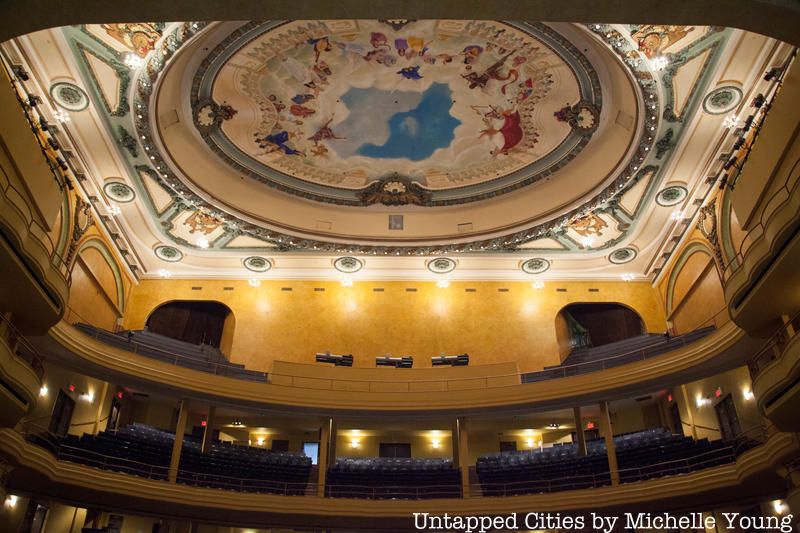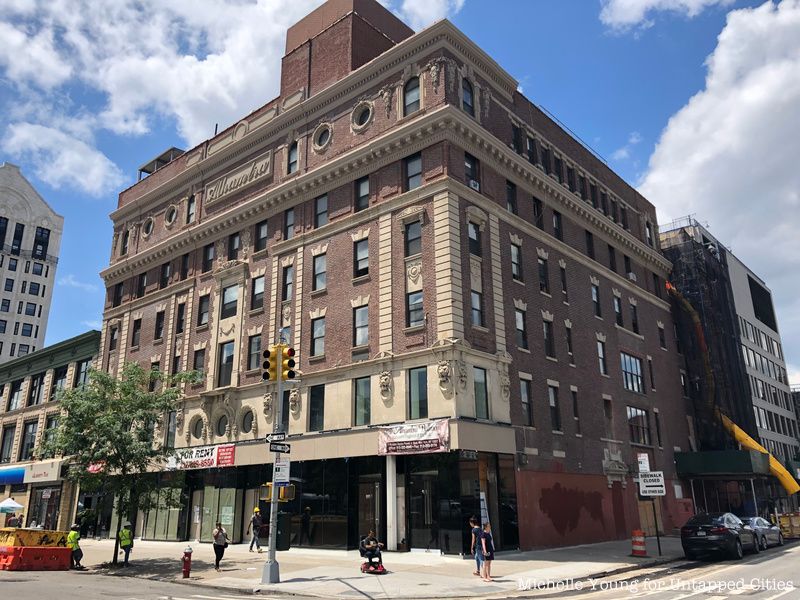The Berkshires Bowling Alley that Inspired "The Big Lebowski"
It’s been 36 years since the release of The Big Lebowski, the irreverent cult comedy by Joel and Ethan



The story of New York City’s ballrooms form one facet of the city-wide story of a changing entertainment industry and real estate market. Many of the iconic music venues survived Prohibition, only to be taken down by the advent of radio and television. The large spaces necessitated diversification of events and venues, causing their musical cache to fall as real estate pressures were rising. This list of New York City’s ballrooms include those lost, those still standing and those converted, as well as new ballrooms adapted from other types of spaces. Not all were music venues, but all have a unique story to tell as part of the city’s history. Here are 12 historic ballrooms:

The Audubon Ballroom at 165th Street and Broadway is most notable for being the site of Malcolm X’s assassination but it was originally the William Fox Audubon Theatre, designed by Thomas Lamb. In 1927, it became one of the first theaters in the area to feature talkies. The second floor of the theater was constructed as a ballroom, which held dances and special events.
After the assassination, the Ballroom closed and was taken over by the City for non-payment of taxes. The former theater was purchased by Columbia, which began demolishing the structure in 1992. Before it was able to completely demolish the building, the University relented to public pressure and reached a compromise with local community groups. Columbia left most of the original Thomas Lamb facade (and even restored it) and provided space for the Malcolm X and Dr. Betty Shabazz Memorial and Educational Center within the building.

Hammerstein Ballroom, located on 34th Street near Penn Station, was first built in 1906 by Oscar Hammerstein I as a venue for the Manhattan Opera Company, a competitor to the Metropolitan Opera at a lower price point. When the Met decided to move to Lincoln Center and supported the demolition of its own original opulent opera house on West 39th Street (as a means to avoid competition from any other opera company taking over the space), the organization also paid Hammsterstein $1.2 million to stop hosting operas at his theater for a period of 10 years. Hammerstein then began to host vaudeville, and later after changing owners was converted into a ballroom, became a Freemasons temple, trade union headquarters, and home to Sun Myung Moon’s Unification Church, who still owns it.
The large 12,000 square foot, multi-level space has hosted everything from music performances, WWE wrestling events, fashion shows and award shows.
https://www.youtube.com/watch?v=Zm3lkV45lY8
Once located at 53rd Street and Broadway, the Palladium Ballroom (not to be confused with The Palladium on 14th Street) is best known for its promotion of Latin big band music. But when it first opened, Palladium Ballroom had a racially restrictive policy until business needs forced it to accept blacks, Puerto Ricans and Cubans into its clientele. Immigration from Latin America after WWII was on the rise, and its population would revolutionize the New York City dance scene. With most of the Latin music was being played uptown, in neighborhoods like Spanish Harlem, the Palladium became the first venue downtown to host a Latin matinee, starting in 1948. Singers like Celia Cruz, Arsenio Rodríguez, Tito Puente, and Desi Arnaz performed here and the success at the Palladium Ballroom spread Latin music to the other venues in the city.
The mambo is also credited to have started at the Palladium in 1948, while the venue also hosted dance competitions, pie contests, and something called the “Female Best Leg Contest.” The Palladium closed in 1966.

Harlem’s Savoy Ballroom was located on 140th Street and Lenox Avenue and took up the second floor of an entire block. An evening at the Savoy Ballroom usually featured two bands, performing in what was considered the world’s most beautiful ballroom. It was a luxury experience, managed by African Americans, and modeled after Roseland Ballroom. Unlike other venues in the city, it never had a discriminatory policy–ability to dance was far more important. The Savoy also participated in the 1939’s World Fair with a performance by the self-proclaimed “World’s Greatest Colored Dancers.”
The Savoy’s place in history, along with the famous performers who came through like Ella Fitzgerald, Benny Goodman, and the Savoy Lindy Hoppers, is well-regarded, but the actual building could not be saved from demolition. The Savoy and neighboring Cotton Club were both demolished for a housing project. Today the only thing to mark its existence is a plaque, installed in 2002.

The Edison Ballroom on West 47th Street was once the grand ballroom of the Edison Hotel, next door, opened in the 1930s. The Art Deco style venue later became a Broadway theater and a Supper Club for dinner and big band music. The venue reopened, after renovation, in 2008, as an event space for weddings and the like. As a result, it’s hard to find a photograph to show its Art Deco core that doesn’t abound with colored lighting and over the top floral bouquets.

Interior bar at Bowery Ballroom
While unassuming from the outside, The Bowery Ballroom on Delancey street can be seen as a microcosm of the economic roller coaster that was the later half of the twentieth century. The structure was built just before the 1929 stock market crash, so due to some bad timing it was vacant until the post World War II economic boom. To serve the new consumer society, the space became a department store. Then, as the city fell into borderline bankruptcy in the 70s, the space fell into decline. It opened as the music venue it is today in 1997. In fact, if you go down to the basement, you can see the remaining brick features of the 1929 theater. Also, all the brass rails and iron exterior metalwork in the venue are from the original theater. Read more about the history here.

The Gowanus Ballroom is a 16,000 square foot exhibition space located along the Gowanus Canal in Brooklyn. In the 1800s, the space was used as a steel mill. In 2010, Josh Young of Serett Metal retooled the space. It’s also currently used as a metal fabrication shop that opens its doors to artists and assists or teaches them to build. See more photos of an exhibition inside this space here.

The Alhambra Ballroom was once the vaudeville theater, the Harlem Alhambra, built in 1905 at 126th Street and Adam Clayton Powell Jr. Boulevard. The ballroom of the Alhambra, also known as “the Auditorium,” wasn’t added to the upstairs until 1929 where artists like Billie Holiday, Jellie Roll Morton, and Bessie Smith performed and swing dancing competitions took place. The original structure was designed by theater architect John Bailey McElfatrick. Like may other grand theaters and ballrooms, the Alhambra also went into a period of decline and re-opened as The Alhambra Ballroom in 2003 as an event venue. A bowling alley is on the 3rd and 4th floor, while the Masonic King Salomon Grand Lodge is also a tenant of the building.

Abandoned interior of the Renaissance Ballroom by AbandonedNYC
Recently in the news because of preservation efforts to save this long deteriorating ballroom in Harlem, the Renaissance Ballroom was a once-swanky venue that hosted dance parties led by bandleaders like Duke Ellington and Count Basie before basketball games of the Harlem Rens, which also took place inside. It was the first theater in New York that was owned and operated by African-Americans and true center for the community. Built in 1921, it housed a 900-seat theater, casino and ballroom. The two-story structure was arranged so that the family activities such as movies and performances were on the first floor, and the commercial space on the second floor held the casino and ballroom.
The “Rennie” closed in 1979 and the property was purchased by the Abyssinian Development Corporation, with a restoration plan to be concluded on the building over the next ten years which never took place. In 1991, the Landmarks Preservation Commission agreed and set out to landmark the complex, but it was never passed. In its abandoned condition, the ballroom was a perfect setting for Spike Lee’s movie “Jungle Fever”, where he used it as a backdrop for the notorious crack den scene.
See more photos of of its abandoned interior here and read more about the Harlem Rens.

The Prince George Hotel, built in the Beaux-Arts style by Howard Greenley in 1904, was one of those destined-to-be-destroyed treasures as it sat decaying for years in the early 1990s on 28th street between 5th Avenue and Madison. Once a lavish hotel most notably known for being the first with private bathrooms in each room, The Prince George fell on hard times in the 1970s when it was purchased and converted by New York City into a welfare hotel—one of the most dangerous and notorious in the city.
In the 1990s, the non-profit Common Ground, an organization dedicated to developing and sustaining supportive and affordable housing for the chronically homeless in New York, purchased the vacant building from the city and through private, state, and federal funds, and collaborating with the Preservation League of New York State and New York Landmarks Conservancy, converted the building back into a livable residence with 416 single occupancy apartments.
n 2004, the momentous renovation of the neo-Renaissance ballroom began, and it is now rented out as The Prince George Ballroom with 100% of the profit feeding back into their non-profit organization.
See more photos of The Prince George Hotel today.

The Broad Street Ballroom at 37-41 Broad Street was originally the headquarters of the Lee-Higginson Bank, a landmarked building. The company did not use the building long, as scandals soon plagued the firm, and the building was sold to the New York Stock Exchange, and later to the Public National Bank and Trust Company. The building was purchased by MetSchools, Inc. a private education company to renovate the building for a Pre-K to Grade 8 private school. Long out of the public eye, the former banking hall was renovated and turned into the Broad Street Ballroom.

Demolition of Roseland Ballroom
Roseland Ballroom, which saw the likes of Frank Sinatra, Louis Armstrong and Ella Fitzgerald, also hosted female prize fighting, weddings, yo yo and sneezing competitions and more. The original location on 51st Street opened in 1917, financed by Frank Yuengling of the D. G. Yuengling & Son beer family. A beer company getting involved on the distribution side was not uncommon practice at the time–in 1903 Pabst Blue Ribbon opened the Pabst Grand Circle Hotel at what is now Columbus Circle, which included a hotel and restaurant as well. Roseland moved to its second location on 52nd Street in 1956, with its recognizable street art style facade–when its original spot was demolished.
Nirvana, Madonna, Beyonce and Metallica also performed in the second location. Lady Gaga was the last performer in residence at Roseland Ballroom and the venue closed on April 7, 2014. The venue had a slow demolition, starting in August 2014 and continuing into 2015. Its future is fairly certain however: a high rise condo is going up in its place.
Next, check out 7 music venues in NYC with a quirky history. This article also written by Benjamin Waldman, Samantha Sokol, Lynn Lieberman, and Corey William Schneider.
Subscribe to our newsletter